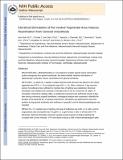Electrical Stimulation of the Ventral Tegmental Area Induces Reanimation from General Anesthesia
Author(s)
Solt, Ken; Van Dort, Christa J.; Chemali, Jessica J.; Taylor, Norman E.; Kenny, Jonathan D.; Brown, Emery N.; ... Show more Show less
DownloadBrown_Electrical stimulation.pdf (681.4Kb)
OPEN_ACCESS_POLICY
Open Access Policy
Creative Commons Attribution-Noncommercial-Share Alike
Terms of use
Metadata
Show full item recordAbstract
Background:: Methylphenidate or a D1 dopamine receptor agonist induces reanimation (active emergence) from general anesthesia. The authors tested whether electrical stimulation of dopaminergic nuclei also induces reanimation from general anesthesia.
Methods:: In adult rats, a bipolar insulated stainless steel electrode was placed in the ventral tegmental area (VTA, n = 5) or substantia nigra (n = 5). After a minimum 7-day recovery period, the isoflurane dose sufficient to maintain loss of righting was established. Electrical stimulation was initiated and increased in intensity every 3 min to a maximum of 120 µA. If stimulation restored the righting reflex, an additional experiment was performed at least 3 days later during continuous propofol anesthesia. Histological analysis was conducted to identify the location of the electrode tip. In separate experiments, stimulation was performed in the prone position during general anesthesia with isoflurane or propofol, and the electroencephalogram was recorded.
Results:: To maintain loss of righting, the dose of isoflurane was 0.9% ± 0.1 vol%, and the target plasma dose of propofol was 4.4 ± 1.1 µg/ml (mean ± SD). In all rats with VTA electrodes, electrical stimulation induced a graded arousal response including righting that increased with current intensity. VTA stimulation induced a shift in electroencephalogram peak power from δ (<4 Hz) to θ (4–8 Hz). In all rats with substantia nigra electrodes, stimulation did not elicit an arousal response or significant electroencephalogram changes.
Conclusions:: Electrical stimulation of the VTA, but not the substantia nigra, induces reanimation during general anesthesia with isoflurane or propofol. These results are consistent with the hypothesis that dopamine release by VTA neurons, but not substantia nigra neurons, induces reanimation from general anesthesia.
Electrical stimulation of the ventral tegmental area, but not of the substantia nigra, restored righting and activated the electroencephalogram during isoflurane or propofol anesthesia. Selective activation of the ventral tegmental area pathway resembled pharmacological activation of dopamine receptors in evoking arousal from anesthesia.
Date issued
2014-08Department
Massachusetts Institute of Technology. Department of Brain and Cognitive SciencesJournal
Anesthesiology
Publisher
Ovid Technologies (Wolters Kluwer) - Lippincott Williams & Wilkins
Citation
Solt, Ken, Christa J. Van Dort, Jessica J. Chemali, Norman E. Taylor, Jonathan D. Kenny, and Emery N. Brown. “Electrical Stimulation of the Ventral Tegmental Area Induces Reanimation from General Anesthesia.” Anesthesiology 121, no. 2 (August 2014): 311–319.
Version: Author's final manuscript
ISSN
0003-3022